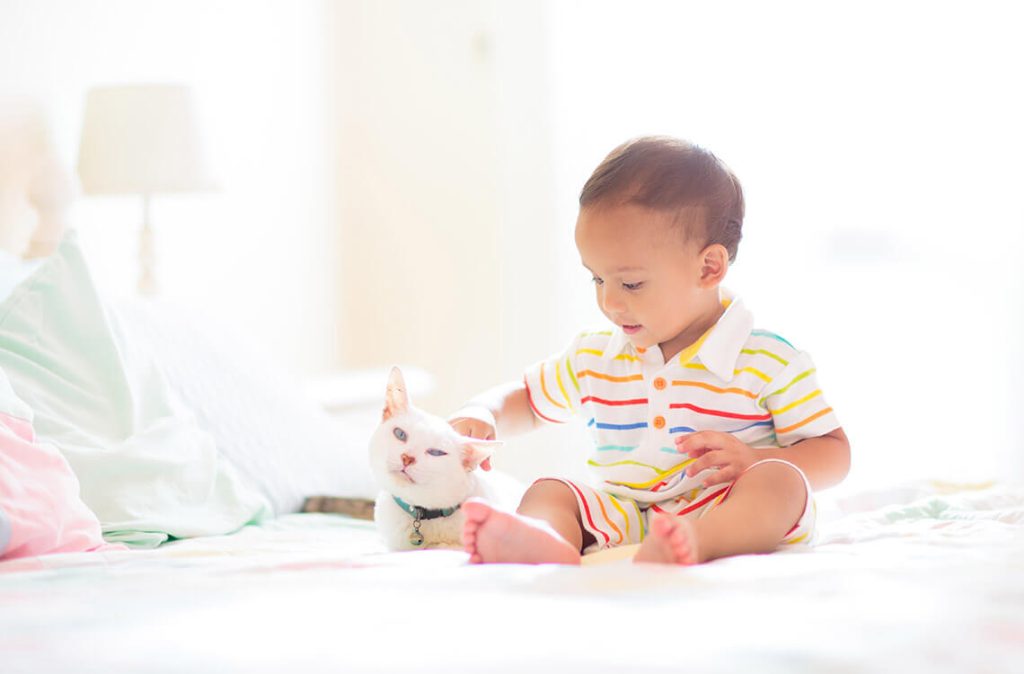Having your fur baby and your actual baby living under the same roof can be a wholesome experience.
But it can also be a tricky relationship to establish.
After all, not all babies get along with pets (or vice versa).
Whether you’re a first-time human parent or pet parent, it’s important to strike the right balance.
But in order to do so it’s important to understand the challenges that come with this arrangement.
Challenges of Having a Baby and a Pet
Safety
We all know about all the many dangers that a pet can pose to a newborn child, or even a toddler.
They can scratch and bite.
In some cases, even a hissy, angry pet can be traumatising for a child to be around.
But the opposite is also true, a grabby baby can also endanger your cat in more ways than one.
They can tug and squeeze and hit your pet and possibly even injure them fatally.
Health
It’s rare for a pet to be allergic to babies.
Other than the initial mistrust or annoyance, pet are generally not averse to babies.
However, the reverse cannot be said.
Babies can often be very allergic to pets in their first few days of life.
Pets release dander and often trail residues from their litter box everywhere around the house.
Introducing bacteria in their surroundings.
Cross-Contamination
In the same topic as ‘health’, sometimes cross contamination of food can occur between pets and babies.
Your baby may reach into your pet’s kibble and munch on them.
And your cat may lick or eat some of your baby’s food (especially if let unattended).
While usually not dangerous, the possibility of contracting certain infections like food poisoning.
That said, here are some tips on how to protect both your pet and your baby.
How to Protect Your Pet and Baby
Ice-breaking
If your pet dislikes children, it’s best to introduce them to your baby gradually.
Limit or avoid exposure within the first few days of bringing your newborn back home.
Keep your baby in a separate room.
However, leave behind clothes or blankets that your baby has slept on for your pets to smell.
Animals are olfactory creatures, which means their sense memories are strong.
Getting them familiarise with your baby’s scent can help your pet adjust to the new family member.
A month or two will usually suffice.
Or longer, if you want to be extra safe.
Hygiene
One of the most important parts of protecting both baby and pet is cleanliness.
You may have to be stringent with your cleaning once you bring a baby into a pet-filled house.
The floors need to be mopped regularly.
In fact, your pet may also have to be bathed quite often.
Or alternatively you can clean their paws and private parts with pet-friendly wet wipes.
Regularly clean and groom your pet to minimise shedding and allergens as well.
Make sure to keep your pet’s claws trimmed or capped to ensure they don’t injure your baby.
Supervision
Never leave your baby and pet alone together unsupervised. Unless they are properly quarantined.
Your pet may have acclimated to having baby on the surface.
But some animals like cats may be temperamental.
They may scratch your baby if startled, or perhaps in some cases, for seemingly no reason at all.
Conversely, you may have a gentle pet but a handsy baby.
Which your pet may not appreciate, especially if they get hurt.
Accidents can always happen.
So, it’s crucial that you’re always present to step-in.
Baby-proofing
Everyone knows about baby-proofing, but did you know that you can also pet-proof your house as well?
Some families are known to install fences or gates to separate their pets and their babies.
This can be especially useful to keep your baby away from an exposed litter box.
Securing an off-limits area can also be more localised.
Play-pens or an enclosed pet house are ideal for this purpose.
Remember to avoid pet cages.
Opt for enclosures with clear plastic or glass walls instead of bars.
After all, your pet is a part of your family, not a prisoner.
Etiquette
Some pets, like dogs, may be too excited to have a baby around for them to play with.
This can often translate as aggressive playing.
If your pet is not already trained, you may want to enrol them in obedience classes.
You can also hire a professional pet trainer to deal any behavioural issues.
Basic commands like ‘sit’ and ‘stay’, can be particularly important when you have a baby in the house.
This ensures you establish clear boundaries.
Keeping your baby safe and your pet happy.
Safe Spaces
Your baby will eventually grow a bit and can run around and play.
This may spell danger for your pet, who may value their personal space.
Babies are naturally curious and may not want to be touched or accosted by a baby 24/7.
Create safe areas for your pet where they can retreat. Especially when they need a break from your baby.
This can be a separate room or a box with comfortable bedding and toys.
Make Your Home Pet- and Baby-Friendly
Establishing a home that is both friendly for pets and babies can take some patience.
However, it’s possible for both your fur baby and human baby to develop a loving and harmonious relationship.
The key is to enforce discipline, boundaries and hygiene.
With any luck, both your babies will grow up to the best of friends for the rest of their lives.
Disclaimer: The information provided in this article is for informational purposes only and should not be considered as medical advice from Motherhood. For any health-related concerns, it is advisable to consult with a qualified healthcare professional or medical practitioner.
For more insightful stories and fun recipes, stay tuned to Motherhood Story!
